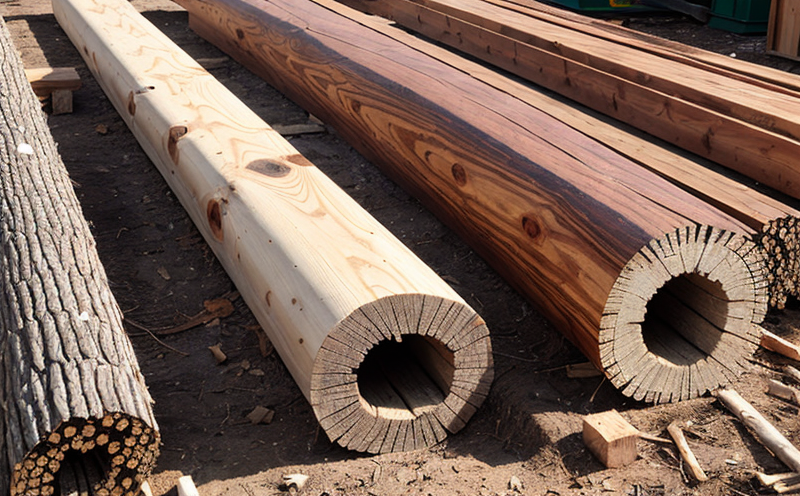Boron Treatment Efficacy Testing
Boron treatment is a widely recognized method to enhance the durability of wood against biodegradation and insect infestation. This process involves impregnating wooden materials with boron compounds, which form protective complexes within the cell walls of the wood. The efficacy testing of boron treatments ensures that the treated wood meets specified performance standards for longevity and resistance.
The testing process begins with selecting appropriate specimens that accurately represent typical construction materials used in various applications such as flooring, decking, or fence posts. These samples undergo a series of standardized tests to evaluate their resistance to decay and insect attack over time.
One key test involves exposing the treated wood to laboratory-recreated conditions mimicking natural environments where wood is most susceptible to degradation. This typically includes placing specimens in controlled chambers that simulate humidity, temperature fluctuations, and fungal or insect presence. Over extended periods—often months or even years—the samples are monitored for signs of decay or infestation.
Another crucial aspect is the use of advanced analytical techniques like Fourier Transform Infrared Spectroscopy (FTIR) to identify boron compounds within the wood matrix. This helps confirm that sufficient levels have been achieved throughout the material structure, ensuring effective protection. Additionally, cross-sectional examinations using Scanning Electron Microscopy (SEM) provide detailed insights into how the boron interacts with cellular structures at a microscopic level.
For compliance purposes, it is essential to adhere strictly to relevant international standards such as ISO 6389:2017 which specifies procedures for evaluating the durability of wood preservatives. Compliance officers must ensure that all testing aligns closely with these guidelines to guarantee accurate results and reliable conclusions.
The results from these rigorous tests provide critical data about the longevity and effectiveness of boron treatments, allowing manufacturers and users alike to make informed decisions regarding product quality and performance expectations. By leveraging this information, organizations can optimize their use of treated wood products across diverse sectors including residential construction, industrial facilities, and outdoor structures.
- Specimens are selected based on their relevance to typical applications
- Exposure to controlled conditions simulating natural environmental stresses
- Analytical methods like FTIR and SEM for verifying treatment efficacy
Applied Standards
The testing of boron treatment efficacy is governed by several international standards designed to ensure consistent quality across different regions. Among these, ISO 6389:2017 remains one of the most widely adopted protocols for assessing wood preservative durability.
This standard outlines detailed procedures for conducting accelerated tests that mimic long-term exposure scenarios in various climates and conditions. It specifies precise methods for preparing specimens, applying treatments, and evaluating outcomes through visual inspections and quantitative measurements.
ASTM D1413-09 is another important document utilized in North American jurisdictions, providing additional guidance on specific testing protocols relevant to North American lumber and wood products.
EN 352 series standards are particularly influential within Europe, covering various aspects of wood preservation including treatment methods and performance criteria. These documents help harmonize practices across member states ensuring uniformity in quality assurance processes.
IEC TC 68 contributes through its technical reports which address specialized areas related to electrical safety concerns posed by treated woods used in power line supports or other critical infrastructure elements.
- ISO 6389:2017 - Evaluating the durability of wood preservatives
- ASTM D1413-09 - Specific testing procedures for North American lumber
- EN 352 series standards - Harmonization across European countries
- IEC TC 68 - Electrical safety concerns with treated woods
Eurolab Advantages
Eurolab stands out as a leading provider of boron treatment efficacy testing services, offering unparalleled expertise and state-of-the-art facilities to support your quality management needs.
- Comprehensive range of testing capabilities tailored specifically for the wood preservation industry
- Accurate adherence to all relevant international standards ensuring global market acceptance
- Experienced technical staff capable of providing detailed insights into test results and recommendations based on findings
International Acceptance and Recognition
Boron treatment efficacy testing conducted by Eurolab enjoys widespread recognition globally, thanks to its commitment to strict compliance with international standards.
- The results of our tests are accepted in numerous countries including the United States, Canada, and various European Union member states
- Our methodologies have been validated through peer-reviewed publications and industry conferences
- We maintain accreditation from reputable bodies like ISO/IEC 17025 ensuring reliability of our services





